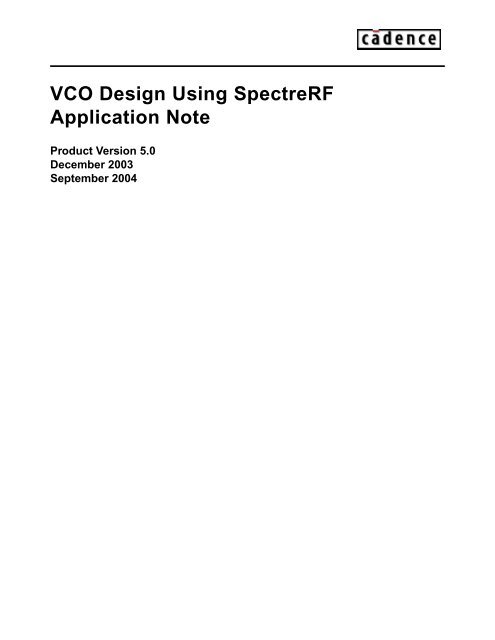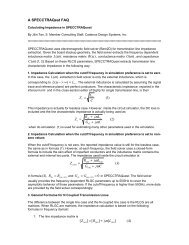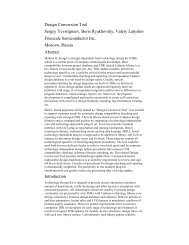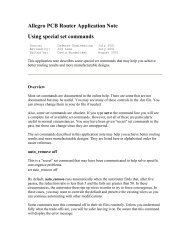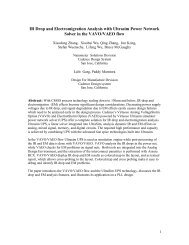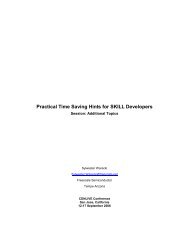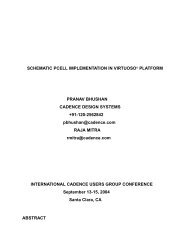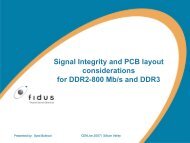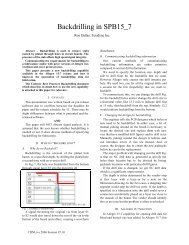VCO Design Using SpectreRF Application Note
VCO Design Using SpectreRF Application Note
VCO Design Using SpectreRF Application Note
- No tags were found...
Create successful ePaper yourself
Turn your PDF publications into a flip-book with our unique Google optimized e-Paper software.
INVENTORY OF LISTINGSAPRIL 2012Office Listings............................................................................................................. page 2CARL TIEDEMANN, SIOR, CRE, CPMPresident, CEO574.296.1311 directtiedeman@fmstone.comJOHN LETHERMAN, CCIMPartner574.296.1308 directjohnl@fmstone.comROSS MILLER, SIORPartner574.296.1301 directrossm@fmstone.comBILL KUHNS, SIOR, RECS, CERSSenior Broker574.296.1303 directbillk@fmstone.comBRENT MILLER, SIORSenior Vice President574.296.1302 directbrentm@fmstone.comPETE LETHERMAN, CCIMSenior Vice President574.296.1310 directpetel@fmstone.comRICHARD HOBSONReal Estate Salesperson574.296.1331 directrichardh@fmstone.comRetail Listings.............................................................................................................. page 4Industrial Listings........................................................................................................ page 6Land Listings............................................................................................................. page 10Investment Listings.................................................................................................... page 13New listings appear highlighted in yellow. Pending listings appear highlighted in blue.Sold/Leased properties appear highlighted in red.The information contained herein was obtained from sources believed to be reliable. We cannot be responsible for errors, omissions, prior sale orlease, withdrawal from the market or change in price, without notice. No liability of any kind is to be imposed on the broker herein.FM Stone Commerciala member of The Tiedemann Group530 E. Lexington AvenueSuite 175Elkhart, IN 46516Office: (574) 522.0390Fax: (574) 295.1711www.fmstone.comwww.thetiedemanngroup.com
© 2003-2004 Cadence <strong>Design</strong> Systems, Inc. All rights reserved.Printed in the United States of America.Cadence <strong>Design</strong> Systems, Inc., 555 River Oaks Parkway, San Jose, CA 95134, USATrademarks: Trademarks and service marks of Cadence <strong>Design</strong> Systems, Inc. (Cadence) contained in thisdocument are attributed to Cadence with the appropriate symbol. For queries regarding Cadence’s trademarks,contact the corporate legal department at the address shown above or call 800.862.4522.All other trademarks are the property of their respective holders.Restricted Print Permission: This publication is protected by copyright and any unauthorized use of thispublication may violate copyright, trademark, and other laws. Except as specified in this permission statement,this publication may not be copied, reproduced, modified, published, uploaded, posted, transmitted, ordistributed in any way, without prior written permission from Cadence. This statement grants you permission toprint one (1) hard copy of this publication subject to the following conditions:1. The publication may be used solely for personal, informational, and noncommercial purposes;2. The publication may not be modified in any way;3. Any copy of the publication or portion thereof must include all original copyright, trademark, and otherproprietary notices and this permission statement; and4. Cadence reserves the right to revoke this authorization at any time, and any such use shall bediscontinued immediately upon written notice from Cadence.Disclaimer: Information in this publication is subject to change without notice and does not represent acommitment on the part of Cadence. Except as may be explicitly set forth in such agreement, Cadence doesnot make, and expressly disclaims, any representations or warranties as to the completeness, accuracy orusefulness of the information contained in this document. Cadence does not warrant that use of suchinformation will not infringe any third party rights, nor does Cadence assume any liability for damages orcosts of any kind that may result from use of such information.Restricted Rights: Use, duplication, or disclosure by the Government is subject to restrictions as set forth inFAR52.227-14 and DFAR252.227-7013 et seq. or its successor.
<strong>VCO</strong> <strong>Design</strong> <strong>Using</strong> <strong>SpectreRF</strong>ContentsVoltage Controlled Oscillator <strong>Design</strong> Measurements . . . . . . . . . 5Purpose . . . . . . . . . . . . . . . . . . . . . . . . . . . . . . . . . . . . . . . . . . . . . . . . . . . . . . . . . . . . 5Audience . . . . . . . . . . . . . . . . . . . . . . . . . . . . . . . . . . . . . . . . . . . . . . . . . . . . . . . . . . . . 5Overview . . . . . . . . . . . . . . . . . . . . . . . . . . . . . . . . . . . . . . . . . . . . . . . . . . . . . . . . . . . 5Introduction to <strong>VCO</strong>s . . . . . . . . . . . . . . . . . . . . . . . . . . . . . . . . . . . . . . . . . . . . . . . . . . . . . 5<strong>VCO</strong> Measurements . . . . . . . . . . . . . . . . . . . . . . . . . . . . . . . . . . . . . . . . . . . . . . . . . . . . 14Output Frequency and Output Power Level . . . . . . . . . . . . . . . . . . . . . . . . . . . . . . . . 15Phase Noise . . . . . . . . . . . . . . . . . . . . . . . . . . . . . . . . . . . . . . . . . . . . . . . . . . . . . . . . 15Frequency Pushing . . . . . . . . . . . . . . . . . . . . . . . . . . . . . . . . . . . . . . . . . . . . . . . . . . . 15Frequency Pulling . . . . . . . . . . . . . . . . . . . . . . . . . . . . . . . . . . . . . . . . . . . . . . . . . . . . 16Tuning Sensitivity and Linearity . . . . . . . . . . . . . . . . . . . . . . . . . . . . . . . . . . . . . . . . . 16Power Dissipation . . . . . . . . . . . . . . . . . . . . . . . . . . . . . . . . . . . . . . . . . . . . . . . . . . . . 16Example <strong>VCO</strong> Measurements . . . . . . . . . . . . . . . . . . . . . . . . . . . . . . . . . . . . . . . . . . . . . 17Example <strong>VCO</strong> Schematic: oscHartley . . . . . . . . . . . . . . . . . . . . . . . . . . . . . . . . . . . . 17Output Frequency and Output Power Level (PSS) . . . . . . . . . . . . . . . . . . . . . . . . . . . 18Phase Noise (PSS and Swept Pnoise) . . . . . . . . . . . . . . . . . . . . . . . . . . . . . . . . . . . 20Frequency Pushing (Swept PSS) . . . . . . . . . . . . . . . . . . . . . . . . . . . . . . . . . . . . . . . . 21Frequency Pulling (Swept PSS on Modified Hartley Schematic) . . . . . . . . . . . . . . . . 23Tuning Sensitivity and Linearity (Swept PSS) . . . . . . . . . . . . . . . . . . . . . . . . . . . . . . 27Power Dissipation (PSS) . . . . . . . . . . . . . . . . . . . . . . . . . . . . . . . . . . . . . . . . . . . . . . 29Conclusions . . . . . . . . . . . . . . . . . . . . . . . . . . . . . . . . . . . . . . . . . . . . . . . . . . . . . . . . . . . 31References . . . . . . . . . . . . . . . . . . . . . . . . . . . . . . . . . . . . . . . . . . . . . . . . . . . . . . . . . . . . 31September 2004 3 Product Version 5.0
<strong>VCO</strong> <strong>Design</strong> <strong>Using</strong> <strong>SpectreRF</strong>September 2004 4 Product Version 5.0
<strong>VCO</strong> <strong>Design</strong> <strong>Using</strong> <strong>SpectreRF</strong>Voltage Controlled Oscillator <strong>Design</strong>MeasurementsThe procedures described in this application note are deliberately broad and generic. Yourspecific design might require procedures that are slightly different from those described here.PurposeThis application note describes how to use <strong>SpectreRF</strong> in the Analog <strong>Design</strong> Environment tomeasure parameters which are important in design verification of voltage controlledoscillators, or <strong>VCO</strong>s.AudienceUsers of <strong>SpectreRF</strong> in the Analog <strong>Design</strong> Environment.OverviewThis application note describes a basic set of the most useful measurements for <strong>VCO</strong>s.Introduction to <strong>VCO</strong>sOscillators generate a reference signal at a particular frequency. In voltage controlledoscillators, or <strong>VCO</strong>s, the frequency of the output varies in proportion to some control signal.Oscillators are generally used in RF circuits to generate the local oscillator, or LO, signal formixers. <strong>VCO</strong>s are used in both receivers, as shown in Figure 1-1, and transmitters, as shownin Figure 1-2.September 2004 5 Product Version 5.0
<strong>VCO</strong> <strong>Design</strong> <strong>Using</strong> <strong>SpectreRF</strong>Voltage Controlled Oscillator <strong>Design</strong> MeasurementsFigure 1-1 Block Diagram of a Typical Superheterodyne ReceiverThe noise performance of a mixer is strongly affected by noise on the LO signal. The LOsignal is always passed through a limiter, which is generally built into the mixer, to make themixer less sensitive to small variations in the amplitude of the LO signal. In addition, alloscillators, except the reference oscillator, are embedded in phase-locked loops to controltheir frequency and reduce their phase noise. (Reference oscillators are generally fixedfrequencycrystal oscillators, and as such have well controlled frequency and noise.)However, oscillators still produce enough variation in the phase of their output to affect theperformance of the tranceiver. Thus, it is important to minimize the phase noise produced bythe oscillator.Figure 1-2 RF Interface for A Digital Direct Conversion TransmitterSeptember 2004 6 Product Version 5.0
<strong>VCO</strong> <strong>Design</strong> <strong>Using</strong> <strong>SpectreRF</strong>Voltage Controlled Oscillator <strong>Design</strong> MeasurementsNonlinear oscillators naturally produce high levels of phase noise. To see why, consider thetrajectory of an oscillator’s stable periodic orbit in state space. Furthermore, considerdisturbing the oscillator by applying an impulse u(t) =δ(t). The oscillator responds by followinga perturbed trajectory x(t) +∆x(t) as shown in Figure 1-3, where■■x (t) represents the unperturbed solution∆x (t) is the perturbation in the response.Figure 1-3 Oscillator Trajectory in State Space With and Without Perturbation ∆xFigure 1-3 shows the trajectory of an oscillator shown in state space with and without aperturbation ∆x. By observing the time stamps (t 0 ,..., t 6 ) you can see that the deviation inamplitude dissipates while the deviation in phase does not.Equation 1-1 shows the decomposition of the perturbed response into amplitude and phasevariations.φ()t(1-1) vt () = xt () + ∆xt () = ( 1+α()t )x⎛t+ ------------ ⎞⎝ 2π f ⎠ 0where■■■■v (t) represents the noisy output voltage of the oscillatorα (t) represents the variation in amplitudeφ (t) is the variation in phasef 0 is the oscillation frequencySeptember 2004 7 Product Version 5.0
<strong>VCO</strong> <strong>Design</strong> <strong>Using</strong> <strong>SpectreRF</strong>Voltage Controlled Oscillator <strong>Design</strong> MeasurementsSince the oscillator is stable and the duration of the disturbance is finite, the deviation inamplitude eventually decays away and the oscillator returns to its stable orbit. In effect, thereis a restoring force that tends to act against amplitude noise. This restoring force is a naturalconsequence of the nonlinear nature of the oscillator and at least partially suppressesamplitude variations, as shown in Figure 1-4. With linear oscillators, there is no restoring forceand so the amplitude is arbitrary (that is, they do not have stable orbits). As such, linearoscillators exhibit equal amounts of amplitude and phase noise because the amplitude noiseis not suppressed.Figure 1-4 Linear Oscillator (left) and Nonlinear Oscillator (right) Each With ItsResponse to NoiseFigure 1-4 shows■■On the left, a linear oscillator and its response to noise.On the right, a nonlinear oscillator and its response to noise.In Figure 1-4, the arrows are phasors that represents the unperturbed oscillator output, thecarriers, while the circles represent the response to perturbations in the form of noise. For thelinear oscillator on the left, the noise simply adds to the carrier. For the nonlinear oscillator onthe right, the nonlinearities act to control the amplitude of the oscillator and so to suppressvariations in amplitude, thereby radially compressing the noise ball and converting it intopredominantly a variation in phase.Since an oscillator is autonomous, any time-shifted version of the solution is also a solution.Once the phase has shifted due to a perturbation, the oscillator continues on as if neverdisturbed except for the shift in the phase of the oscillation. There is no restoring force on thephase and so phase deviations accumulate. This is true for both linear and nonlinearoscillators. Notice that there is only one degree of freedom — the phase of the oscillator asa whole. There is no restoring force when the phase of all signals associated with theoscillator shift together, however there would be a restoring force if the phase of signalsshifted relative to each other. This is important in oscillators with multiple outputs, such asquadrature oscillators or ring oscillators. The dominant phase variations appear identically inSeptember 2004 8 Product Version 5.0
<strong>VCO</strong> <strong>Design</strong> <strong>Using</strong> <strong>SpectreRF</strong>Voltage Controlled Oscillator <strong>Design</strong> Measurementsall outputs, whereas relative phase variations between the outputs are naturally suppressedby the oscillator or added by subsequent circuitry and so tend to be much smaller.After being disturbed by an impulse, the asymptotic response of the amplitude deviation isα (t) → 0ast →∞. However, the asymptotic response of the phase deviation is φ(t) →∆φ.Ifresponses that decay away are neglected then the impulse response of the phase deviationφ(t) can be approximated with a unit step s (t). Thus, Equation 1-2 shows the phase shift overtime for an arbitrary input disturbance u.(1-2)∞φ() t ∼ st ( – τ)u( τ) dτ∫–∞=t∫–∞u( τ) dτEquation 1-3 shows the power spectral density (PSD) of the phase.(1-3)S φ( f )S u( f )∼ ----------------( 2πf ) 2The disturbance u might be either deterministic or random in character. It might result fromextraneous signals coupling into the oscillator or from variations in the components that makeup the oscillator, such as thermal, shot, and flicker noise.If S u ( f ) is white noise, then S φ ( f ) is proportional to 1 /(2πf ) 2 . This result has been shownhere to apply at low frequencies, but with a more detailed derivation the result can also beshown to be true over a broad range of frequencies. Assume u is white and define a such that(1-4)f 20S φ( f ) = a ------f 2where f 0 = 1 / T is the oscillation or carrier frequency. S φ is the PSD of the phase variable inEquation 1-1 on page 7. Phase cannot easily be observed directly, so instead you are ofteninterested in S v , the PSD of v. near the fundamental [1].September 2004 9 Product Version 5.0
<strong>VCO</strong> <strong>Design</strong> <strong>Using</strong> <strong>SpectreRF</strong>Voltage Controlled Oscillator <strong>Design</strong> Measurementsaf2S v( f 0+ f m) X 2 0= ----------------------------------1a 2 π 2 f4 0 + f 2mwhere f m is the frequency offset from the fundamental and X 1 is the first Fourier coefficient forx,xt () =∞∑ X ke j2πkf 0tk = – ∞This spectrum is a Lorentzian as shown in Figure 1-5. The corner frequency f ∆ is known asthe linewidth of the oscillator and is given by f ∆ = aπf 0 2 , withS v( f 0+ f m) =X 21f ∆------------ ---------------------π f 2∆+ f 2mFigure 1-5 Different Ways to Characterize Noise in the Same OscillatorFigure 1-5 shows two different ways of characterizing noise in the same oscillator. S φ is thespectral density of the phase and S v is the spectral density of the voltage. S v contains bothamplitude and phase noise components, but with oscillators the phase noise dominatesexcept at frequencies far from the carrier and its harmonics. S v is directly observable on aspectrum analyzer, whereas S φ is only observable if the signal is first passed through a phasedetector. Another measure of oscillator noise is L, which is simply S v normalized to the powerin the fundamental.September 2004 10 Product Version 5.0
<strong>VCO</strong> <strong>Design</strong> <strong>Using</strong> <strong>SpectreRF</strong>Voltage Controlled Oscillator <strong>Design</strong> MeasurementsAs t →∞ the phase of the oscillator drifts without bound, and so S φ (f m ) →∞ as f m →0.However, even as the phase drifts without bound, the excursion in the voltage is limited by thediameter of the limit cycle of the oscillator (represented by the periodic function x inEquation 1-1 on page 7). Therefore, as f m →0 the PSD of v flattens out and2X 1S v( f 0+ f m) → ------------π f ∆which is inversely proportional to a. Thus, the larger a, the more phase noise, the broader thelinewidth, and the lower signal amplitude within the linewidth. This happens because thephase noise does not affect the total power in the signal, it only affects its distribution. Withoutphase noise, S v (f) is a series of impulse functions at the harmonics of f 0 . With phase noise,the impulse functions spread, becoming fatter and shorter but retaining the same total power.It is more common to report oscillator phase noise as L, the ratio of the single-sideband (SSB)phase noise power to the power in the fundamental (in dBc/Hz)(1-5)L ( f m)S v( f 0+ f m)= ------------------------------- =X 21f1 ∆-- ---------------------π f 2∆+ f 2mAt frequencies where the oscillator phase noise dominates over the amplitude noise, and thatare also outside the linewidth (f m > f ∆ ), the phase noise is approximated with(1-6)f ∆af20L ( f m) = ----------- = --------- = Sπ f 2 f 2 φ( f m) for f ∆« f « f 0m mOther references report that L (f m )=S φ (f m ) / 2, which is true when S φ is the single-sided PSD[1]. Here S φ is the doubled-sided PSD.The roll-off in S v (f 0 + f m ) and L (f m )asf m → 0 is a result of the circuit responding in a nonlinearfashion to the noise itself. As such, it cannot be anticipated by the small-signal noiseanalyses. However, as you can see from Figure 1-5, S φ does not roll-off at low frequencies,so you can use these analyses along with Equation 1-6 to compute S φ at low frequencies.September 2004 11 Product Version 5.0
<strong>VCO</strong> <strong>Design</strong> <strong>Using</strong> <strong>SpectreRF</strong>Voltage Controlled Oscillator <strong>Design</strong> MeasurementsWhen the perturbation consists of the white and flicker noise, the phase-noise S φ (f m ) will takethe form shown in Equation 1-7 [1].⎛(1-7) S φ( f m) af2 1f ⎞ c= ⎜0------- + -------⎟⎜ 2 3 ⎟⎝f mf m⎠Thus, you can characterize the oscillator’s response to white and flicker noise sources usingjust two parameters, af 02and f c , where■■af 0 2 is the portion of the phase-noise attributable to the white noise sources alone atf m = 1 Hz. You can extract this by simply extrapolating to 1 Hz from a frequency wherethe noise from the white noise sources dominates.f c is the flicker noise corner frequency, where white noise and flicker noise have the samecontribution to phase noise.Figure 1-6 shows an oscillator phase noise curve.Figure 1-6 Typical Phase Noise Curve for an Oscillator<strong>SpectreRF</strong> uses the following general procedure to measure oscillator noise.1. Perform a periodic steady state (PSS) analysis.2. Use the measured periodic steady state as the operation point to obtain the linearperiodic time varying (LPTV) model.September 2004 12 Product Version 5.0
<strong>VCO</strong> <strong>Design</strong> <strong>Using</strong> <strong>SpectreRF</strong>Voltage Controlled Oscillator <strong>Design</strong> Measurements3. Calculate the total voltage noise contribution at the output from every noise source usingthe LPTV model.4. Scale the voltage-noise spectrum by the power of the fundamental to obtain the phasenoise spectrum using Equation 1-6.Because an oscillator LPTV model has a singularity pole at f 0 , the oscillation frequency, thetotal output noise calculated using the LPTV model approaches infinity as f m → 0. However,this is not physically correct because the nonlinearity of the oscillator limits the voltageamplitude and the LPTV model ignores the nonlinearity effect. Therefore, the correct S v ( f )curve should be flat in the vicinity of f 0 .Although the amplitude of the voltage at the output is bounded due to the nonlinearity effect,the phase of the voltage is not bounded. So the phase noise grows as the offset frequencyf m →0.Physically this means that if the frequency of the perturbation to the oscillator is thesame as its oscillation frequency, the phase of the output voltage will accumulate and growwithout bound.Since the voltage noise calculated from the LPTV model also grows as the offset frequencyapproaches 0, the phase noise calculated by the voltage noise from the LPTV model is stillcorrect using Equation 1-6 for small offset frequency.Now the question becomes how to get the real S v ( f ) from the calculated S v ( f ) using the LPTVmodel. In other words, you must estimate the linewidth where S v ( f ) is becoming flat. Withoutthe flicker noise, the linewidth isf ∆= aπf 2 0and you can obtain af 0 2 from the extrapolated S φ at 1 Hz due to white noise. Calculate thelinewidth by integrating L( f m ) over f m and set the result equal to 0.When both white noise and flicker noise exist, you can use a similar technique to obtain theapproximate linewidth as in Equation 1-8.(1-8)a 2 f 4 + af 2 0 0 f c+ ( π – 1)af 2 0Phase noise acts to vary the period of the oscillation, a phenomenon known as jitter. Onejitter metric is k-period jitter, which is defined as the time for k periods, as shown in Equation1-9.September 2004 13 Product Version 5.0
<strong>VCO</strong> <strong>Design</strong> <strong>Using</strong> <strong>SpectreRF</strong>Voltage Controlled Oscillator <strong>Design</strong> Measurements(1-9){ J k= t n + k– t n– kT}Consider the relationship between the phase and k-period jitter as shown in Equation 1-10,(1-10)( φ( t n + k)– φ( t n)–2πk)J k= -------------------------------------------------------------2πfThe variance of the k-period jitter and phase-noise are related as shown in Equation 1-11 [2].(1-11)2 2TJ --------- 2 ∞= kπ 2 ∫ S φ ( f ) sin 2 ( πfkT)d f0When you substitute the S φ from Equation 1-7 on page 12 into Equation 1-11 and ignore theflicker noise part, the k-period jitter is defined as in Equation 1-12.(1-12)J 2k= akTObtain the parameter a by extrapolating S φ at 1 Hz due to white noise. When the flicker noisepart exists in phase noise, the integration in Equation 1-11 is not bounded. It shows that thevalue of k-period jitter is undefined when there is any flicker noise component in the oscillatorphase noise because the result is dependent on how long the jitter is observed and how manysamples the measurement takes.<strong>VCO</strong> MeasurementsTo achieve optimal circuit performance, you should measure and evaluate several <strong>VCO</strong>characteristics or parameters under varying conditions. As an example, one fundamentalparameter is the plot of <strong>VCO</strong> output frequency versus tuning voltage. An extension of thisparameter is tuning sensitivity (expressed in Hz/V), which is the differential of the outputfrequency versus tuning voltage curve. The slope change as a function of frequency is ofparamount importance since this is a critical design parameter.September 2004 14 Product Version 5.0
<strong>VCO</strong> <strong>Design</strong> <strong>Using</strong> <strong>SpectreRF</strong>Voltage Controlled Oscillator <strong>Design</strong> MeasurementsIn practice, both of these parameters should be evaluated under different supply (Vcc)conditions since the output frequency may shift with Vcc changes. This DC power sensitivityis called frequency pushing.The RF power output is also a function of both Vcc and output frequency. You should evaluatethe RF power output since an output power level that is too low results in excessive noise andan output power level that is too high creates distortion and consumes excess DC power.Moreover, the DC power has the chance to translate Vcc noise into oscillator outputmodulation and noise.There are many parameters you must evaluate that are not covered in this application note.The parameters that are covered in this application note are listed and described in thefollowing sections.Output Frequency and Output Power LevelUsually you cannot specify an analysis period for an autonomous circuit because you do notknow the precise oscillation period in advance. To that end, you can estimate the oscillationperiod and <strong>SpectreRF</strong> will compute the correct period. The output power of a <strong>VCO</strong> is typicallyexpressed in dBm.Phase NoisePhase noise is random phase variation in the <strong>VCO</strong>’s output oscillating signal. Close to thecarrier phase noise is mainly composed of flicker noise. The flicker noise measured in a <strong>VCO</strong>is generated only by the active devices, such as the transistor and the tuning diode. Thephase noise is measured at distances from 1 KHz off the carrier to several megahertz (MHz)off the carrier in a 1-Hz bandwidth. Phase noise is the ratio of the output power divided by thenoise power at a specified value and is expressed in dBc/Hz. Phase noise is the mostsignificant source of noise in oscillators, which makes it a crucial measurement.Frequency PushingFrequency pushing is the variation of the <strong>VCO</strong> output frequency due to a change in thepower supply (Vcc). One way to measure frequency pushing is as follows.1. Set the supply voltage (Vcc) at its nominal setting and compute the <strong>VCO</strong> frequency fordifferent tune voltages.2. Increase the supply voltage by a specific amount, ∆v, and measure the <strong>VCO</strong> frequencyfor different tune voltages as before.September 2004 15 Product Version 5.0
<strong>VCO</strong> <strong>Design</strong> <strong>Using</strong> <strong>SpectreRF</strong>Voltage Controlled Oscillator <strong>Design</strong> Measurements3. Decrease the supply voltage by the same amount, ∆v, from the nominal value, andmeasure the frequency for different tune voltages as before.At a given tuning voltage, the frequency change due to a 1 volt supply voltage change yieldsthe frequency pushing. Frequency pushing may be different at different tuning voltages.Frequency PullingFrequency pulling is a measure of frequency change due to a non-ideal load. You measurefrequency pulling by noting the frequency change caused by a load having a nominal 12 dBreturn loss with all possible phases. You should minimize frequency pulling, especially incases where power stages are close to the <strong>VCO</strong> unit and short pulses might affect the outputfrequency.Tuning Sensitivity and LinearityTuning sensitivity is defined as the frequency change per unit of tuning voltage. Ideallytuning sensitivity would be constant but in practice this is generally not the case.1. Compute the <strong>VCO</strong> frequency for different tuning voltages.2. Plot <strong>VCO</strong> frequency measurements against tuning voltage. The slope of thischaracteristic is the tuning voltage sensitivity which you can calculate at different tuningvoltages.The tuning sensitivity is expressed in Hz/V.Power DissipationPower Dissipation arises from the following sources:■■■Dynamic power dissipation due to switching current from charging and dischargingparasitic capacitance.Dynamic power dissipation due to short-circuit current when both n-channel andp-channel transistors are momentarily on at the same time.Static power dissipation due to leakage current and subthreshold current.<strong>VCO</strong>s suffer from trade-offs between speed, power dissipation, and noise. Typically, theydrain from 1 to megawatts, mW, of power.September 2004 16 Product Version 5.0
<strong>VCO</strong> <strong>Design</strong> <strong>Using</strong> <strong>SpectreRF</strong>Voltage Controlled Oscillator <strong>Design</strong> MeasurementsExample <strong>VCO</strong> MeasurementsThe <strong>VCO</strong> measurements in the following sections are calculated using <strong>SpectreRF</strong> version 5.0in the analog design environment.Example <strong>VCO</strong> Schematic: oscHartley<strong>Note</strong>: In Version 5.1.41 USR1 and later, you will find the oscHartley <strong>VCO</strong> schematic in therfExamples library which is available with the Virtuoso ® <strong>SpectreRF</strong> Simulator Option.The oscHartley oscillator circuit that was chosen to conduct the measurements described in“<strong>VCO</strong> Measurements” on page 14 is shown in Figure 1-7 on page 18. The oscHartley <strong>VCO</strong>uses the basic Hartley topology and is tunable between 720 MHz and 1.1 GHz. Theoscillation frequency (F o ) is determined by the resonant circuit made up of inductors (L0, L1)and the C1 capacitor. In this particular <strong>VCO</strong>, the values of L1 and L2 are fixed whereas thevalue of C1 is variable.In this example, the resonant circuit’s capacitor C1 serves as a varactor diode. As a result, thevaractor diode’s junction capacitance, Cvar, is a function of the applied voltage as shown inequation 1-13.(1-13) Cvar⎛ ⎞⎜ C j0 ⎟= ⎜------------------⎟ϒ⎜⎛V1 + --- ⎞⎟⎝⎝φ⎠⎠Where■■■■V = applied junction voltage (V)C j0 = junction capacitance (F) for V = 0 Vφ = barrier potential (V)ϒ= junction gradient coefficientThe varactor diode for this <strong>VCO</strong> has the following values■■C j0 = 8 pFφ = 0.75 V■ ϒ= 0.4September 2004 17 Product Version 5.0
<strong>VCO</strong> <strong>Design</strong> <strong>Using</strong> <strong>SpectreRF</strong>Voltage Controlled Oscillator <strong>Design</strong> MeasurementsBecause Cvar is inversely proportional to V, and Fo is inversely proportional to Cvar, theoscillation frequency is proportional to V. In other words, as you increase V, Cvar decreasesand Fo increases.Figure 1-7 The Hartley OscillatorOutput Frequency and Output Power Level (PSS)Testbench:Hartley Oscillator in Figure 1-7.September 2004 18 Product Version 5.0
<strong>VCO</strong> <strong>Design</strong> <strong>Using</strong> <strong>SpectreRF</strong>Voltage Controlled Oscillator <strong>Design</strong> MeasurementsInitial Conditions/Kickstart:Pulse source.Set Up the Analysis:Set up a PSS analysis with■Beat Frequency = 600 M■ Number of Harmonics =3■■■■■errpreset = moderatetstab = 120 nEnable the oscillator buttonSet Oscillator node = /VoutSet Reference node = /gnd!Run the Simulation:Before you run the PSS analysis, to obtain the Output Power Level at the load, you must savecurrent at the /Vout net through the Analog <strong>Design</strong> Environment. The Outputs section ofthe Analog <strong>Design</strong> Environment window must display, /Vout with the Save column set toyes.Run the PSS analysis.Display/Data Analysis:<strong>SpectreRF</strong> outputs a Fundamental Frequency = 1.1149 GHz in the Spectre log file.Select Results--Direct Plot--Main Form; press on the Power button; select Net (specifyR) and set Resistance = 10 K; press the dBm button; and finally select the /Vout net onthe schematic. The plot in Figure 1-8 is displayed.September 2004 19 Product Version 5.0
<strong>VCO</strong> <strong>Design</strong> <strong>Using</strong> <strong>SpectreRF</strong>Voltage Controlled Oscillator <strong>Design</strong> MeasurementsFigure 1-8 Output Frequency and Output Power Level PlotPhase Noise (PSS and Swept Pnoise)Testbench:Hartley Oscillator in Figure 1-7 on page 18.Initial Conditions/Kickstart:Pulse source.Set Up the Analyses:Set up a PSS analysis and a Swept Pnoise analysis.■ Set up a PSS analysis with a Beat Frequency = 600 M; Number of Harmonics = 3;errpreset = moderate; tstab = 120 n; enable the oscillator button; setOscillator node = /Vout; and Reference node = /gnd!.■ Set up a swept Pnoise analysis with a Sweeptype = relative; Relative Harmonic =1;Frequency Sweep Range (Start =1K,Stop = 10 M); set Sweeptype = logarithmic; Number of Steps = 100; Maximum sideband = 15; setSeptember 2004 20 Product Version 5.0
<strong>VCO</strong> <strong>Design</strong> <strong>Using</strong> <strong>SpectreRF</strong>Voltage Controlled Oscillator <strong>Design</strong> MeasurementsOutput = voltage; Positive Outtput Node = /Vout!; Negative Output Node = /gnd!, and Input Source = none.Run the Simulation:Run the PSS and swept Pnoise analyses.Display/Data Analysis:Click Results--Direct Plot--Main Form; enable the pnoise button; click on the PhaseNoise button; and finally click on Plot. The plot in Figure 1-9 will be displayed.Figure 1-9 Phase Noise PlotFrequency Pushing (Swept PSS)Testbench:Hartley Oscillator in Figure 1-7 on page 18.September 2004 21 Product Version 5.0
<strong>VCO</strong> <strong>Design</strong> <strong>Using</strong> <strong>SpectreRF</strong>Voltage Controlled Oscillator <strong>Design</strong> MeasurementsInitial Conditions/Kickstart:Pulse source.Set Up the Analysis:Calculate frequency pushing with a swept PSS analysis. Parametrize the Vcc supply variableand run a swept PSS analysis for different values of the Vcc parameter. To do this, edit theobject properties of the vpulse source cellname, and change the value of voltage 2 from5 V to fvcc V, then select Check and Save for the schematic.Set up a swept PSS analysis with a Beat Frequency = 1.115 G; Number ofHarmonics =3;errpreset = moderate; tstab = 120 n; enable the oscillator button; setOscillator node = /Vout; and Reference node = /gnd!; enable the Sweep button; enterfvcc as Variable Name; set the Sweep Range Start = 4 and Stop = 6; set SweepType = linear; and Number of Steps = 10.Run the Simulation:Run the swept PSS analysis.Display/Data Analysis:Click Results--Direct Plot--Main Form; click on the Harmonic Frequency button,highlight the 1-st harmonic in the Harmonic Frequency section; and press on the plotbutton. The plot in Figure 1-10 is displayed.September 2004 22 Product Version 5.0
<strong>VCO</strong> <strong>Design</strong> <strong>Using</strong> <strong>SpectreRF</strong>Voltage Controlled Oscillator <strong>Design</strong> MeasurementsFigure 1-10 Frequency PushingFrequency Pulling (Swept PSS on Modified Hartley Schematic)Make frequency pull calculations on a Modified copy of the Hartley Oscillator shown inFigure 1-7 on page 18.Testbench:Modify the Hartley Oscillator shown in Figure 1-7 on page 18 for frequency pull calculations.➤Copy the Hartley schematic and modify the copy as followsa. Connect an instance of a PortAdaptor to the load.b. Select the PortAdaptor you just added, choose Edit-Properties-Objects, enterthe following data and click Apply:❍ Frequency = 1.115 G;❍Phase of Gamma = theta;September 2004 23 Product Version 5.0
<strong>VCO</strong> <strong>Design</strong> <strong>Using</strong> <strong>SpectreRF</strong>Voltage Controlled Oscillator <strong>Design</strong> Measurements❍ Mag of Gamma = 0.2512❍Reference Resistance = 10K (this value must equal the load).<strong>Note</strong>: To find out how to place an instance of a PortAdaptor in a schematic, read thetransmitter modeling chapter in the <strong>SpectreRF</strong> User’s Guide.Frequency pulling is the measurement of frequency change caused by a load having anominal 12 dB return loss with all possible phases. The value of Mag of Gamma, 0.2512,is computed from the return loss value, rl, using the following formula:rl=– 20Log Γwhere Γ is the reflection coefficient with respect to a source impedance R 0 .The modified Hartley oscillator used to calculate frequency pulling is displayed in Figure 1-11.September 2004 24 Product Version 5.0
<strong>VCO</strong> <strong>Design</strong> <strong>Using</strong> <strong>SpectreRF</strong>Voltage Controlled Oscillator <strong>Design</strong> MeasurementsFigure 1-11 Hartley Oscillator Modified for Frequency Pull MeasurementsInitial Conditions/Kickstart:Pulse source.Set Up the Analysis:Calculate frequency pulling with a swept PSS analysis. Set up a swept PSS analysis with thethe theta parameter varying from 0 to 359 degrees.Set up a swept PSS analysis with Beat Frequency = 1.115G; Number of Harmonics =3;errpreset = moderate; tstab = 120n; enable the oscillator button; set Oscillator node = /September 2004 25 Product Version 5.0
<strong>VCO</strong> <strong>Design</strong> <strong>Using</strong> <strong>SpectreRF</strong>Voltage Controlled Oscillator <strong>Design</strong> MeasurementsVout; and Reference node = /gnd!; enable the Sweep button; enter theta as VariableName; set the Sweep Range Start = 0 and Stop = 359; set Sweep Type = linear; andNumber of Steps = 10.Run the Simulation:Run the swept PSS analysis.Display/Data Analysis:Click Results--Direct Plot--Main form; click on the Harmonic Frequency button; highlightthe 1-st harmonic in the Harmonic Frequency section; and press on the Plot button. Theplot in Figure 1-12 is displayed.Figure 1-12 Frequency PullingThe peak to peak difference in the displayed frequency in Figure 1-12 gives the load pull.September 2004 26 Product Version 5.0
<strong>VCO</strong> <strong>Design</strong> <strong>Using</strong> <strong>SpectreRF</strong>Voltage Controlled Oscillator <strong>Design</strong> MeasurementsTuning Sensitivity and Linearity (Swept PSS)Testbench:The original, unmodified Hartley Oscillator shown in Figure 1-7 on page 18.Initial Conditions/Kickstart:Pulse source.Set Up the Analysis:Run a swept PSS analysis with a Beat Frequency = 1.115G; Number of Harmonics = 3,errpreset = moderate, tstab = 120n. Enable the oscillator button, set Oscillator node = /Vout, and Reference node = /gnd!. Enable the Sweep button, enter V_cntl as VariableName (this is the tuning voltage), set the Sweep Range Start = 0 and Stop = 6, set SweepType = linear, and Number of Steps = 6.Run the Simulation:Run the swept PSS analysis.Display/Data Analysis:Click Results--Direct Plot--Main form, click on the Harmonic Frequency button, highlightthe 1-st harmonic in the Harmonic Frequency section and press the Plot button. The plotin Figure 1-13 is displayed.September 2004 27 Product Version 5.0
<strong>VCO</strong> <strong>Design</strong> <strong>Using</strong> <strong>SpectreRF</strong>Voltage Controlled Oscillator <strong>Design</strong> MeasurementsFigure 1-13 Frequency Change per Unit Volt of Tuning VoltageFigure 1-13 represents the frequency change per unit volt of tuning voltage.September 2004 28 Product Version 5.0
<strong>VCO</strong> <strong>Design</strong> <strong>Using</strong> <strong>SpectreRF</strong>Voltage Controlled Oscillator <strong>Design</strong> MeasurementsFigure 1-14 Tuning Voltage SensitivityFigure 1-14 represents the tuning voltage sensitivity. Use the Calculator function in theAnolog <strong>Design</strong> Environment to create this plot.Power Dissipation (PSS)Testbench:The original, unmodified Hartley Oscillator shown in Figure 1-7 on page 18.Initial Conditions/Kickstart:Pulse source.Set Up the Analysis:Set up a PSS analysis with a Beat Frequency = 1.115G; Number of Harmonics = 3;errpreset = moderate; tstab = 120n; enable the oscillator button; set Oscillator node = /Vout; and Reference node = /gnd!.September 2004 29 Product Version 5.0
<strong>VCO</strong> <strong>Design</strong> <strong>Using</strong> <strong>SpectreRF</strong>Voltage Controlled Oscillator <strong>Design</strong> MeasurementsRun the Simulation:Run the PSS analysis.To obtain the Power Dissipation, before you run the PSS analysis, you must save data at theVcc terminal through the analog design environment. The Outputs section of the analogdesign environment window must display, p(/V0/PLUS /vcc!) with the Save column setto yes.Display/Data Analysis:Click Results--Direct Plot--Main form. Highlight the Power button, select Terminal,highlight the dB10 button. In the schematic, select the V0/PLUS terminal of the Vcc powersupply and press the Plot button. The plot in Figure 1-15 is displayed.Figure 1-15 Power DissipationPower dissipation is the value that corresponds to the DC value in Figure 1-15; that is, atfreq = 0.0 the power dissipation value is equal to -16.81 dB or 13.19 dBm.September 2004 30 Product Version 5.0
<strong>VCO</strong> <strong>Design</strong> <strong>Using</strong> <strong>SpectreRF</strong>Voltage Controlled Oscillator <strong>Design</strong> MeasurementsConclusionsThis application note describes some of the most useful measurements for <strong>VCO</strong>s. <strong>SpectreRF</strong>measurements such as Frequency Pushing, Frequency Pulling, Tuning Sensitivity, PowerDissipation, and Linearity are discussed.References[1] Ken Kundert, “Introduction to RF Simulation and Its <strong>Application</strong>”, www.designersguide.com[2] Ken Kundert, “Predicting the Phase Noise and Jitter of PLL-Based FrequencySynthesizers”, www.designers-guide.com[3] Ken Kundert, Manolis Terrovitis, “Converting Phase-Noise to Jitter”, Cadence report.September 2004 31 Product Version 5.0


